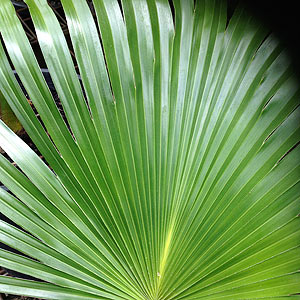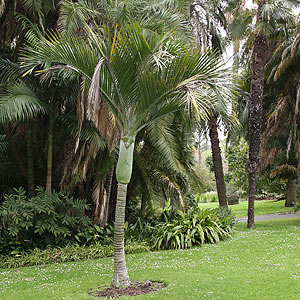Palm Tree Types and Nursery Guide

Palm trees and tropical palm trees are a popular nursery plant as they are widely used in gardens and with so many palm tree types available it is fairly easy to find the right palm for your landscaping needs.
With a good range of specialist Palm Tree Nurseries with a wide range of palm trees for sale it is easy to find a palm tree suitable for most situations.
We include some palm tree pictures and photographs as well as a list of palm tree types or palm tree species. Palm Trees are popular in many states especially in California and Florida where palm trees are used widely in landscaping.
Palm Tree Care
The most important part of Palm Tree care is choosing the right variety for the climate and location.
Some Palm Trees are suited to cold climates, and others are not. Some require a lot of moisture, others are more drought tolerant. And then you have size and root system considerations.
So instead of selecting a palm tree on looks, start :
- Climate
- Soil
- Size and Height
- Root system restrictions
- Single or multi trunk.

Palm TreeVarieties
With so many Palm Tree varieties we have listed some of the most popular garden varieties, along with the common names. Pictured right we have the wonderful Hedyscepe canterburyana or Umbrella Palm. It is the sole member of the genus and a beautiful smaller palm tree to around 20 ft in height.
Popular Palm Tree Varieties Include :
- Acrocomia aculeata :: Spiny royal, Macaw palm
- Archontophoenix alexandrae :: Alexandra Palm
- Archontophoenix cunninghamiana :: King Palm or Bangalow Palm
- Areca triandra :: Triandra Palm
- Arenga tremula :: Dwarf Sugar Palm
- Bismarckia nobilis :: Bismarck Palm, Bismarckia Palm
- Brahea dulcis:: Rock palm, Sombrero palm
- Butia capitata :: Jelly palm, Wine palm
- Carpentaria acuminata :: Carpie, Carpentaria Palm
- Caryota mitis :: Clustering Fishtail Palm
- Chamaedorea metallica :: Metallic Palm
- Chamaedorea seifrizii :: Florida Bamboo Palm
- Clinostigma savoryanum :: Pacific beauty palm
- Cocos nucifera :: Coconut palm
- Copernicia cowellii :: Cabbage palm
- Cryosophila warscewiczii :: Rootspine Palm
- Cycas revoluta :: Sago palm
- Cyrtostachys lakka :: Red Sealing Wax Palm, Lipstick Palm
- Cyrtostachys renda :: Lipstick palm, Sealing wax palm
- Dypsis baronii :: White Crownshaft Palm
- Dypsis decary :: Triangle Palm
- Dypsis gracilis :: Pink Crown Palm
- Dypsis leptocheilos :: Teddy Bear Palm, Red Neck
- Dypsis lutescens :: Golden Cane Palm
- Dypsis pinnatifrons ‘pink crown’
- Howea forsteriana :: Kentia Palm, Sentry Palm
- Hedyscepe canterburyana :: Umbrella Palm or Big Mountain Palm
- Hyophorbe lagenicaulis :: Bottle Palm
- Laccospadix australasica :: Atherton Palm
- Latania loddigesii :: Blue Latan Palm
- Licuala grandis :: Ruffled Fan Palm
- Licuala ramsayi :: Australian Fan Palm
- Normanbya normanbyi :: Queensland Black palm
- Phoenix canariensi :: Canary Island Date Palm
- Phoenix dactylifera :: Date Palm
- Phoenix roebelenii :: Dwarf Date Palm, Pygmy Date Palm
- Pritchardia pacifica :: Fiji Fan Palm
- Ptychosperma elegans :: Solitaire Palm
- Ptychosperma macarthuri :: Macarthur Palm
- Ravenea rivularis :: Majestic Palm
- Rhapis excelsa :: Lady Palm
- Roystonea oleracea :: South American, Venezuelan Royal Palm
- Roystonea regia :: Cuban Royal Palm
- Sabal minor :: Dwarf Palmetto
- Syagrus romanzoffiana ‘Queen Palm’
- Thrinax parviflora :: Mountain Thatch Palm
- Trachycarpus fortunei’ :: Windmill Palm
- Veitchia merrillii :: Manila palm
- Washingtonia robusta :: Mexican Fan Palm
- Wodyetia bifurcata :: Foxtail Palm
- Zombia antillarum :: Zombie palm
Propagation
Generally from seed.
You may also be interested in
- Windmill Palms
- Sable Palm
- Pindo Palms
- Foxtail Palms
- Sago Palm
- Washingtonia Palms
Pruning
Some palm trees are ‘Self cleaning’, others are not.
A self cleaning palm tree will drop the old fronds of its own accord, no need to prune. Other varieties will simply let the old dead frond droop downwards, they will eventually drop off, however you will have a permanent skirt of old foliage.
Many gardeners like to neatly ‘collar’ , palm trees. This means that the old fronds are cut off neatly before they fall.
So consider pruning requirements before you choose which variety to plant.
More Information
- Palm Tree are popular in a number of states particularly those with warmer climates such as Florida, Hawaii, South Carolina, California and parts of Arizona. However palm tree varieties that can grow in cooler climates, or smaller types that can be grown indoors make the sought over in many areas.
- The Sabal Palm, Coconut Palm, Cabbage Palm and Royal Palm and Mexican Fan Palm are amongst the most popular.
- Not all palm trees have coconuts, only the coconut palm itself, and that is Cocos nucifera.
Palm Trees are available for sale from the following growers
SILVERTHORN RANCH NURSERY – phone: 760-728-9051
1826 S. Alturas St. Fallbrook California 92028
Wholesale growers and online suppliers of Agaves, Cactus, Succulents, Yuccas, Euphorbias, Palms, Golden Barrel cactus, With Cites Permits for export. Assorted sizes 4″ up to 30 gallon box plants
EXOTIC PALMS – phone: (305) 246-3125
by appointment Miami Florida
Palm nursery specialising in rare, exotic and unusual species of palms.

